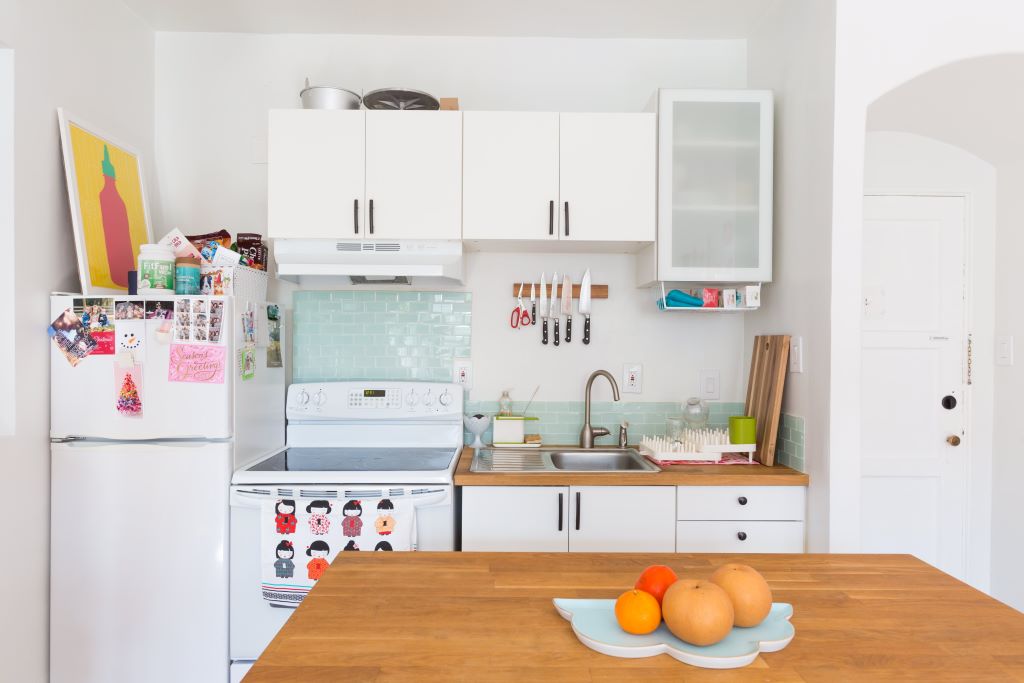In modern homes, small kitchens are a common challenge. As living spaces continue to shrink, kitchens often become the most cramped areas of the house. However, a small kitchen doesn’t have to feel disorganized or overwhelming. By embracing clever organization strategies, you can make the most of every inch of space, turning your kitchen into an efficient and functional environment. Proper kitchen organization is more than just about fitting everything in; it’s about creating a space that works for you, promotes ease of use, and allows you to enjoy cooking and entertaining, even in the tightest of quarters. Whether you have limited counter space, minimal cabinetry, or a combination of both, implementing smart storage solutions will give you the freedom to move, store, and cook with ease.
Table of Contents
ToggleBenefits of Small Kitchen Organization
-
Increased Efficiency
When your kitchen is well-organized, you can find what you need quickly. Studies have shown that effective kitchen organization reduces cooking prep time by as much as 30%. Items stored logically and within reach make cooking easier, allowing you to enjoy your meals without the stress of constant searching.
-
Maximized Space
Small kitchens require creative thinking to maximize every square foot. Organizing items vertically, using multi-functional appliances, or investing in pull-out shelves increases storage capacity, making the kitchen feel more spacious. A well-organized kitchen can accommodate more than you think.
-
Enhanced Aesthetic Appeal
A clutter-free, neatly organized kitchen looks more inviting and visually appealing. According to design experts, even the smallest kitchen can feel larger and more open with proper organization. Utilizing sleek storage solutions and keeping countertops clear creates a modern, clean space that reflects both style and functionality.
-
Reduced Stress and Clutter
A chaotic kitchen can quickly lead to stress and frustration. An organized kitchen, on the other hand, promotes a calm and productive atmosphere. Everything has its place, and you know exactly where to find what you need. This can make cooking and meal preparation feel like a breeze.
1. Embrace Vertical Space
When countertop and cabinet space is limited, look upward. Utilizing vertical space can significantly enhance storage in small kitchens. Installing wall-mounted shelves or racks allows you to store items like spices, utensils, and cookware without cluttering your counters. This approach not only frees up valuable workspace but also keeps essential items within easy reach.
2. Invest in Multi-Functional Tools
In a small kitchen, every tool should serve multiple purposes. For instance, the Staub Spatula Spoon acts as both a spatula and a spoon, ideal for mixing, scooping, and serving. Similarly, KitchenAid Multipurpose Shears function as scissors, nutcrackers, and bottle openers. Choosing such versatile tools reduces the number of items you need to store, thereby saving space.
3. Utilize Cabinet Doors
The inside of cabinet doors offers untapped storage potential. Attaching hooks or small racks can hold measuring spoons, pot lids, or cutting boards. This clever use of space keeps your kitchen essentials organized and easily accessible without occupying shelf or counter space.
4. Opt for Magnetic Knife Holders
Traditional knife blocks consume valuable counter space and can harbor bacteria. Magnetic knife holders, such as the Jonathan Alden Magnetic Wooden Knife Bar, provide a hygienic and space-saving alternative. They keep your knives accessible and add a modern touch to your kitchen decor.
5. Implement Pull-Out Drawers
Deep cabinets can become black holes where items get lost. Installing pull-out drawers ensures that all your kitchenware is visible and accessible. This modification maximizes storage efficiency and minimizes the frustration of searching for items.
6. Use Stackable Containers
Uniform, stackable containers make the most of limited pantry space. They keep dry goods organized and easily visible, reducing the time spent searching for ingredients. Clear containers are particularly beneficial as they allow you to see contents at a glance.
7. Install Under-Shelf Baskets
Under-shelf baskets create additional storage without the need for permanent fixtures. They are perfect for storing items like dish towels, cutting boards, or lightweight dishes. This simple addition can significantly increase your storage capacity.
8. Hang Pots and Pans
Pots and pans are bulky and can consume a lot of cabinet space. Hanging them on a wall-mounted rack keeps them accessible and frees up cabinet space for other items. This method also adds a rustic charm to your kitchen decor.
9. Choose Foldable Furniture
Foldable furniture, such as drop-leaf tables or collapsible chairs, provides flexibility in a small kitchen. They can be tucked away when not in use, freeing up valuable floor space. This adaptability is crucial in maintaining an open and functional kitchen area.
10. Incorporate Lazy Susans
Lazy Susans are rotating trays that make items at the back of cabinets easily accessible. They are particularly useful in corner cabinets where space is often underutilized. This simple tool ensures that all your supplies are within reach, enhancing kitchen efficiency.
11. Use Over-the-Sink Cutting Boards
An over-the-sink cutting board extends your workspace without requiring additional counter space. It allows you to prep food directly over the sink, making cleanup effortless. This tool is invaluable in small kitchens where counter space is at a premium.
12. Install Toe-Kick Drawers
The space beneath your lower cabinets, known as the toe-kick area, is often overlooked. Installing shallow drawers in this space can provide storage for flat items like baking sheets or cutting boards. This clever use of space ensures that no area in your kitchen goes to waste.
13. Utilize Corner Shelves
Corners often become dead space in a kitchen. Installing corner shelves can transform these areas into functional storage for cookbooks, decorative items, or frequently used ingredients. This addition enhances both the utility and aesthetics of your kitchen.
14. Implement Drawer Dividers
Drawers can quickly become cluttered without proper organization. Using dividers helps categorize utensils, making them easier to find and reducing mess. This simple addition can significantly improve the functionality of your kitchen drawers.
15. Opt for Slimmer Appliances
In a small kitchen, every inch matters. Many brands now offer space-saving appliances without compromising functionality. Look for narrow dishwashers, compact refrigerators, and slim-profile microwaves. According to the Association of Home Appliance Manufacturers, sales of compact appliances have risen by 15% over the past five years as more people downsize their living spaces. A slim refrigerator, for example, can free up valuable counter space while still offering ample storage. Opting for appliances with multiple functions—such as an air fryer that also works as a toaster oven—further enhances efficiency.
16. Store Baking Sheets Vertically
Instead of stacking baking sheets and cutting boards horizontally, store them vertically in a rack or file organizer. This simple trick makes grabbing what you need much easier while preventing clutter. A study by the National Kitchen and Bath Association found that vertical storage solutions can improve kitchen efficiency by 30%, as they prevent wasted time rummaging through stacked items. Using a dish rack or tension rods inside a cabinet helps create these vertical storage compartments.
17. Maximize Pantry Space with Door Organizers
Pantry space is often tight in small kitchens. Adding an over-the-door organizer can create additional storage for spices, condiments, and small pantry items. This method utilizes otherwise wasted space while keeping items visible and accessible. Research from The Spruce shows that well-organized pantries reduce grocery waste by 20%, as people can easily see what they have before buying duplicates.
18. Install Floating Shelves
Floating shelves provide additional storage without overwhelming the space. They can hold cookbooks, decorative pieces, or frequently used ingredients. Unlike bulky cabinets, floating shelves maintain an open and airy feel in a small kitchen. According to interior designers, open shelving can make a space look 15% larger by drawing the eye upward. Choose minimalist, sturdy shelves that blend with your kitchen’s style for a clean and modern look.
19. Use a Rolling Cart for Extra Storage
A rolling kitchen cart can function as a movable prep station, storage unit, or bar cart. It provides additional counter space when needed and can be tucked away when not in use. Many small-kitchen owners swear by IKEA’s RÅSKOG cart, which is compact, durable, and highly versatile. A survey by Apartment Therapy revealed that 60% of small-home residents use a rolling cart in their kitchens for added flexibility.
20. Store Spices in a Drawer or Mounted Rack
Traditional spice racks take up counter or cabinet space, which is limited in small kitchens. Instead, use a drawer with labeled jars or install a wall-mounted spice rack. Studies show that organizing spices in an accessible way can save up to 10 minutes per meal preparation. Magnetic spice racks on the side of the fridge or cabinet doors are also great options for keeping your ingredients within reach.
Frequently Asked Questions (FAQs) About Small Kitchen Organization
1. What is the best way to organize a small kitchen?
Utilizing vertical space, choosing multifunctional appliances, and decluttering are key strategies. Store items based on frequency of use for efficiency.
2. How do I maximize counter space in a tiny kitchen?
Use over-the-sink cutting boards, wall-mounted storage, and nesting cookware. Avoid leaving unnecessary appliances on the counter.
3. What are the best storage containers for a small kitchen?
Stackable, clear containers with airtight seals help maximize storage while keeping ingredients fresh and visible.
4. How can I store pots and pans without taking up too much space?
Hanging them on a wall rack or using a pull-out drawer organizer can save cabinet space and improve accessibility.
5. Are open shelves a good idea for small kitchens?
Yes, they create an airy feel and provide easy access to frequently used items. However, they require regular tidying to avoid clutter.
6. How can I keep my small kitchen clutter-free?
Regularly declutter, use space-saving tools, and store items in designated places. Follow the “one in, one out” rule to prevent accumulation.
7. Can I make my small kitchen look bigger?
Yes! Use light colors, reflective surfaces, and streamlined storage solutions. Avoid overcrowding counters and keep decor minimal.
Final Thoughts
Clever kitchen organization in small spaces requires creativity and strategic planning. By utilizing vertical storage, multi-functional tools, and space-saving furniture, you can transform even the tiniest kitchen into a highly efficient and stylish workspace. With these expert-backed tips, your kitchen will feel more spacious, functional, and enjoyable to use. Whether you’re a home cook or just trying to make the most of limited space, these solutions will help you maximize every inch!
Read More: Interior design: open concept kitchens



